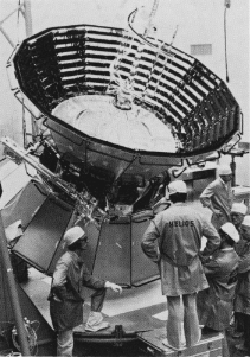Helios 2
Helios 2

The Helios 2 satellite. (Credit: NASA)
Lifetime: January 1976 - December 1979
Portion(s) of spectrum studied:
Country (primary): West Germany and the United States
Primary Science
The Helios 2 spacecraft was one of a pair of probes launched to study solar processes. The primary mission of these spacecraft was to make measurements of the interplanetary medium from the vicinity of Earth's orbit to 0.3 AU.
High Energy Science
The first instrument that could explore a linear time profile of gamma-ray bursts was on the Helios 2 satellite.
Science Highlights
- Provided fine time resolution of gamma-ray bursts
- When combined with data from its contemporary satellites (ISEE 3, Venera 11, Venera 12, and others), provided new tools for pinpointing the location of gamma-ray bursts and discovering the nature and origin of these bursts.

